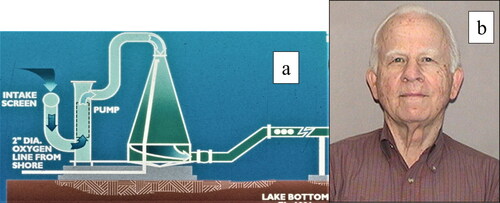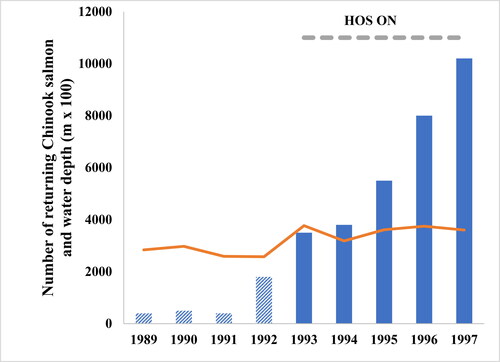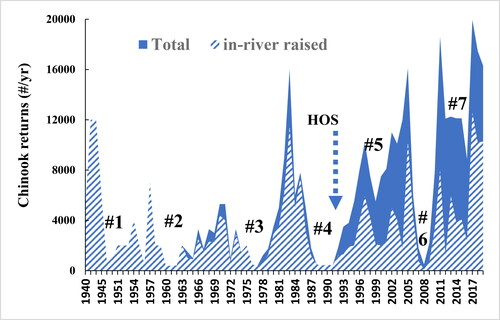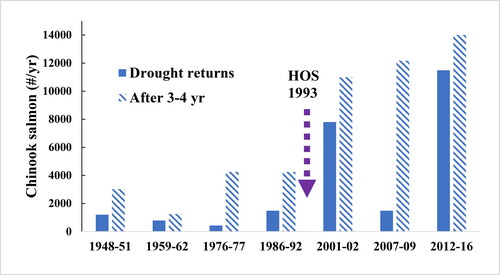Figures & data
Figure 1. (a) Diagram of the Camanche Reservoir Speece cone (7 m high, 3.7 m wide at the base), showing the 5.1 cm (2 inch) diameter inlet pure oxygen gas hose, the inlet pipe containing the 0.9 m3/s water pump leading to the top of the cone, and the outlet from the bottom of the cone to the 45 m long diffuser pipe. (b) Professor Richard Speece, inventor of the cone.

Table 1 Schematic of effects of HOS on life stages of Chinook salmon and steelhead.
Figure 2. Annual returns for adult Chinook salmon between 1989 and 1997 before (hatched bars) and after (clear bars) HOS operating in summer–fall (dashed line). Increases can be attributed to improved water quality conditions in the river below the dam once pollutants had been reduced by HOS. It takes 3–4 yr before a fish hatched either in the hatchery or river in 1993 migrates to sea, matures, and returns, i.e., 1996–1997. During the 1987–1992 drought water depth (line) averaged 27.4 m, compared with 35.8 m post-drought (1993–1997), but both depths permit stable thermal stratification.

Table 2. Effects of HOS on returning adult Chinook salmon before and after HOS, which began in July 1993, compared with the long-term average of record prior to HOS.
Figure 3. Improvement in depth fish distribution due to HOS. Data show distribution of fish, as shown by echolocation, in 4 layers of the reservoir. Prior to HOS, fish were confined to the oxygenated upper water. No fish were recorded in the lower hypolimnion prior to HOS.

Table 3. Depth distribution of larger fish, as sonar echoes, in 4 layers of water before (Jun 1992) and after (Sep 1993) HOS, which commenced in late July 1993.
Figure 4. Long-term (1940–2019) returns of adult Chinook salmon. Total fish returns (solid) and hatchery spawned fish (hatched area). Arrow shows HOS start in 1993. Low returns occurred in droughts (1–4) prior to HOS but were higher in droughts after HOS. Best return was drought 7, where HOS was supplemented with upstream reservoir releases. Low drought returns for drought 6 (2007–2009) were due to “poor ocean conditions,” but 3–4 yr after, in 2012–2015, returns were high.

Figure 5. Effect of HOS on adult Chinook returns in droughts (solid bar) and 3 yr later (hatched bar). Drought returns and the 3 yr post-drought returns were low prior to HOS, but most droughts after HOS showed higher returns during and after droughts. The 2007–2009 returns were due to poor ocean conditions that affected all of California’s Sacramento River hatcheries.

Table 4. Sacramento River Basin drought intensities and returns of adult Chinook salmon during droughts as a percentage of the long-term mean.
Table 5. Capital costs for the Camanche Reservoir Speece cone.
Figure 6. Operation and management costs for the Camanche Reservoir HOS relative to other costs for the reservoir and fish hatchery. Costs inflation-adjusted; 2 recent upgrades also amortized over 20 yr to be comparable with HOS.

Table 6. Details of operating and maintenance costs of the Camanche Reservoir HOS.
Table 7. Cost comparison with other Speece cones and pure oxygen addition systems (Mobley-type bubble plumes) and Blue-in-Green Inc.-type superoxygen side stream (from Wagner Citation2015).
Table 8. Whole-reservoir costs for removal of the main nutrients that cause eutrophication calculated from decreases in concentration in Camanche Reservoir due to HOS and comparison with 2 other methods to achieve the same reduction.
Table 9. Targeted in-plume (smaller volume) costs to remove TP, turbidity, and heavy metals or add oxygen in the hypolimnion outlet region using HOS in Camanche Reservoir.
